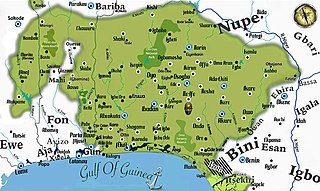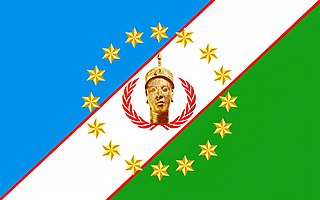Related Research Articles

Oduduwa was a Yoruba divine king, legendary founder of the Ife Empire and a creator deity (orisha) in the Yoruba religion. According to tradition, he was the holder of the title of the Olofin of Ile-Ife, the Yoruba holy city. He ruled briefly in Ife, and also served as the progenitor of a number of independent royal dynasties in Yorubaland.

Ifẹ̀ is an ancient Yoruba city in south-western Nigeria, recent in-depth archeologically estimates suggest Ife's founding to be between the 10th century BC and 6th century BC and is widely agreed upon by historians to be the oldest amongst the classical and post-classical Yoruba city-states. The city is located in present-day Osun State. Ifẹ̀ is about 218 kilometers northeast of Lagos with a population of over 500,000 people, which is the highest in Osun State according to population census of 2006.

Yorubaland is the homeland and cultural region of the Yoruba people in West Africa. It spans the modern-day countries of Nigeria, Togo and Benin, and covers a total land area of 142,114 km2. Of this land area, 106,016 km2 (74.6%) lies within Nigeria, 18.9% in Benin, and the remaining 6.5% is in Togo. Prior to European colonization, a portion of this area was known as Yoruba country. The geo-cultural space contains an estimated 55 million people, the majority of this population being ethnic Yoruba.

The Oyo Empire was a Yoruba empire in West Africa. It was located in present-day southern Benin and western Nigeria. The empire grew to become the largest Yoruba-speaking state through the organizational and administrative efforts of the Yoruba people, trade, as well as the military use of cavalry. The Oyo Empire was one of the most politically important states in Western Africa from the mid-17th to the late 18th century, and held sway not only over most of the other kingdoms in Yorubaland, but also over nearby African states, notably the Fon Kingdom of Dahomey in the modern Republic of Benin on its west.

Chief Daniel Olorunfẹmi Fágúnwà MBE, popularly known as D. O. Fágúnwà, was a Nigerian author of Yorùbá heritage who pioneered the Yorùbá language novel.
Ketu is the name of a Yoruba subgroup, historical kingdom and region straddling parts of what is now southeastern Republic of Benin and parts of southwest Nigeria. The chief town and traditional capital of the area was the town of Kétou (Ketu), which is considered to be one of the oldest capitals of the Yoruba-speaking people, tracing its establishment to a settlement founded by a descendant of Oduduwa called Sopasan or Soipasan. The Oba of the town were traditionally styled "Alaketu", and are related directly to Ile-Ife in present-day Nigeria. Other towns that were historically part of the Ketu Kingdom are;
Chief Ògúnwán̄dé "Wán̄dé" Abím̄bọ́lá is a Nigerian academician, a professor of Yoruba language and literature, and a former vice-chancellor of the University of Ife. He has also served as the Majority Leader of the Senate of the Federal Republic of Nigeria. Chief Abimbola was installed as Àwísẹ Awo Àgbàyé in 1981 by the Ooni of Ife on the recommendation of a conclave of Babalawos of Yorubaland.
Ọ̀rànmíyàn, also known as Ọranyan, was a legendary Yoruba king from the kingdom of Ile-Ife, and the founder of the Oyo empire. Although he was the youngest of the descendants of Oduduwa, he became the prime heir of Oduduwa upon his return to claim his grandfather's throne.

The Legends of Africa reflect a wide-ranging series of kings, queens, chiefs and other leaders from across the African continent including Mali, Benin, Ghana, Nigeria, Congo, Ethiopia, Eritrea and South Africa.

The documented history begins when Oranyan came to rule the Oyo Empire, which became dominant in the early 17th century. The older traditions of the formerly dominant Ile-Ife kingdom are largely oral.

The Yoruba of West Africa are responsible for a distinct artistic tradition in Africa, a tradition that remains vital and influential today.

The Yoruba people are a West African ethnic group who mainly inhabit parts of Nigeria, Benin, and Togo. The areas of these countries primarily inhabited by the Yoruba are often collectively referred to as Yorubaland. The Yoruba constitute more than 48 million people in Africa, are over a million outside the continent, and bear further representation among members of the African diaspora. The vast majority of the Yoruba population is today within the country of Nigeria, where they make up 15.5% of the country's population according to CIA estimations, making them one of the largest ethnic groups in Africa. Most Yoruba people speak the Yoruba language, which is the Niger-Congo language with the largest number of native or L1 speakers.

Ado-Odo is the metropolitan headquarters of the kingdom of Ado, renowned for its Oduduwa/Obatala temple, the ancient fortress of the traditional practice of Ifá. Oodu'a is also regarded by traditionalists as the mother of all deities worldwide. All of these made Ado an inviolate territory in western Yorubaland—the same "father-figure" status accorded to Ile-Ife. Unlike the other kingdoms, which had at one time or the other engaged in the internecine wars that ravaged Yorubaland in the nineteenth century, Ado stood out as an unconquered sanctuary city-state throughout the period.
Stephen Adebanji Akintoye, also known as S. Banji Akintoye, is a Nigerian-born academic, historian and writer. He attended Christ's School Ado Ekiti, Nigeria from 1951–1955, and studied history at the University College, Ibadan (1956–1961), and doctoral studies from 1963-1966 at the University of Ibadan, where he was awarded a PhD in History in 1966. He taught at the History Department at Obafemi Awolowo University, Ile-Ife, Nigeria, where he became a professor and Director of the Institute of African Studies from 1974-1977. He has also taught African History in universities in the United States including the University of South Florida, Tampa, Florida; Montgomery County Community College, PA, and Eastern University, St. Davids, Pennsylvania. Akintoye has written four books, chapters in many joint books, and several articles in scholarly journals. He took a leading part for some time in the politics of Nigeria and served on the Nigerian Senate from 1979–1983 during the Second Republic. He currently lives in Cotonoue, Benin Republic. Akintoye is one of the current leading scholars on the history of the Yoruba people. His most recent work, A History of the Yoruba People, draws on decades of new findings and thinking on Yoruba studies that challenges some previously dominant notions about the origins of the Yoruba. This work dispels the Middle Eastern and Arabia origins propounded by such scholars as the late Samuel Johnson (1846–1901) and also gave prominence to the works on the Pre-Oduduwa Period by Ulli Beier among others. Akintoye also gave prominence to the role of Ilé-Ifè over that of Oyo. A reviewer, Wale Adebanwi, notes: "...this book directly contests and shifts th e focus of Yoruba history away from what many have called the Oyo-centric account of Samuel Johnson... Where Johnson avoids the creation myth that positions Ife as the sacred locus of Oduduwa's original descent and the orirun (creation-source), Akintoye, justifiably, restores Ile-Ife to its proper place as "ibi ojumo ti mon wa'ye" ..."
An Oba's crown represents the highest level of authority vested in Yoruba rulers. Referred to as an Adé, the bead-embroidered crown is the foremost attribute of the ruler and the greatest mark of honour and sanction of divine authority. An Oba's crown may also be referred to as an Adé ńlá, literally: Big Crown. Ade in Yorubaland are elaborate conical head gears that feature a heavily beaded veil and fringes that shields or obscure the face.


Obalufon Alayemore, also referenced as Ọbalùfọ̀n II or just Alayemore, was the Third Ooni of Ife, a paramount traditional ruler of the Ife Empire. He succeeded his father Obalufon Ogbogbodirin. Obalufon Alayemore was forced out of power by Ooni Oranmiyan and later returned with the help of local residents to reclaim the throne.
Emmanuel Olakunle Filani is a Nigerian educator and artist. His works are closely identified with the school of thought named Onaism, an art movement that is based on the fusion of the designs, ornamentation and motifs found in traditional Yoruba carvings and textiles with modern art pieces such as drawings and paintings. Filani is also a lecturer and an administrator – he was a provost of the Federal College of Education, Osiele, Abeokuta.
The Isha sometimes spelt Ica, and Itcha are a relatively small group of the Yoruba people, situated in the western parts of middle Benin, West Africa, especially in the town of Bantè and other surrounding communities in the Collines Department.

The Ife Empire was the first empire in Yoruba history. It was founded in what is now southwestern Nigeria and eastern Benin. The Ife Empire lasted from 1200 to 1420. The empire was formed by Odùduwà, and became well-known for its sophisticated art pieces. Although Yoruba was the main language of the empire, there were also various spoken dialects and languages. It rose to power through trade with Sahelian and forest states. Its capital city, Ilé-Ife, was one of the largest urban centers in 14th century West Africa.
References
- ↑ University of California, Los Angeles. (1967). African arts. Vol 30, p43
- ↑ Harris, M. D. (1996). Contemporary yoruba art in ile-ife: History, continuum, motive, and transformation. Available from ProQuest Dissertations & Theses Globa, p172
- ↑ Harris p165
- ↑ Leslie Lyon (February 28, 2011). "Race, gender and sexuality in African art". University of Texas at Austen News. Retrieved October 11, 2015.